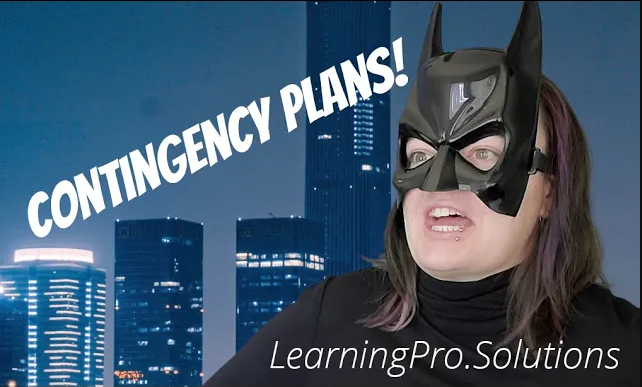Long Lines and Little Mistakes in the Time of the Great Resignation
This is a summary of the video I recently uploaded to my Youtube channel. It should give you a decent outline of my thoughts on what we need to do as Instructional Designers in during this time of mass resignations. However, the full video includes a lot more jokes about Batman and playing detective in the grocery store, so I suggest you watch it to get the full experience.
Most of us have seen the “Great Resignation” headlines over the past year, but let’s look at a quick definition to make sure we’re all on the same page:
The Great Resignation… is an economic trend in which employees voluntarily resign from their jobs en masse, beginning in early 2021, primarily in the United States.
From Wikipedia
Employees are very quickly moving up the corporate ladder and into new jobs, often motivated by the rapid increase in pay or by important conditions, such as remote work.
Overall, this is great! I’m very supportive of employees being able to have proper work-life balance. And I must admit, as someone with an uncommon neurotype and 2 chronic illnesses, I’m selfishly invested in this trend! I’m healthier than I’ve been in ages because I work from home, which means I can regulate my diet, insulin, and executive function needs how and when I want to. You can find all the articles you want on the amazing benefits of working from home (I recommend this one and this one, and Pew Research Center just released their study on the Great Resignation this month)
I’m here today to shift the focus a bit: it’s great that employees have better working conditions. But as conditions improve, employees will follow those jobs. This has evolved into something of an elevator, with different people moving into new and improved positions at a rapid rate, and leaving those at the bottom of the corporate ladder with little support (if you’ve noticed how long the lines at the grocery store are, or how much your call time has increased when calling a help line- it’s that!) So how do we deal, as corporations and as people, with the fact that everyone is new at their jobs? I have two strategies:
Mercury’s in Retrograde for the Foreseeable Future
My fellow Wicca readers may recognize this astrology term: Retrograde is a time for missed communication, so when I joke about “acting like it’s retrograde,” I mean that it’s useful to double checking that everyone’s on the same page. It means preparing to double-check people’s work, and it means saving documentation of any work you receive.
Break Out the Bat-Contingency Plans
Taking my cues from the caped crusader, I’ve learned recently that it’s always good to have a contingency plan. Having back-up strategies in the form of Plan B (or even Plan C or Plan D) will serve you well right now. So, what do these strategies mean for us as Instructional Designers? Let’s look at a case study from a past job.
Case Study – A Call Center Kerfuffle
At my last position, we had a new hire program that… let’s just say it needed updating, and leave it at that. If a new learner was relying on that material alone, they wouldn’t be able to complete a customer service call. However, this program saw dozens of new employees go through it and still receive customer satisfaction scores that consistently scored 90% or higher. This was possible because the facilitators of the program had been in their positions for years. They knew the ins and outs of the point-of-sale system, and if they didn’t know the answer to something, they knew the expert that did.
What happens if all those people leave?
Suddenly the network of experts that the training program relied on for tribal knowledge would vaporize. I can only assume that company has raised the salaries of the people facilitating that program to incentivize them to stay, or they’re scrambling now to avoid the pickle they’re finding themselves in with all their experts gone.
Meanwhile, they’re most likely still hiring new employees. Which means where a supervisor may once have spent years at the company, they’re now likely to have spent only months. Extending that line of logic out, that means if an employee is faced with a tricky situation and needs to escalate to their supervisor, the supervisor is less likely to have encountered that situation before, and less likely to know what to do. So what would some potential solutions be for this situation?
On-Demand Materials to the Rescue
The need for on-demand training has never been more urgent. Employees need to be able to find answers to their questions quickly or, in an ideal world, not have to go searching for them at all. What if a bot was installed in the employee’s point-of-sale system? It could pop up with a decision tree as soon as the employee begins a specific procedure, and guide them to the correct resolution. Perhaps they could click a “cancellation” button and have an offboarding form populate in their dashboard. This would be much easier than having the employee take time to search through a (let’s face it, likely outdated) knowledgebase and locate the form themselves, while also trying to select the correct options in their point-of-sale system and keep the customer talking.
This is where my Retrograde strategy comes in; we’re basically trying to eliminate as many opportunities for miscommunication as possible!
Helping One Another
As Instructional Designers, we need to make sure we’re sharing knowledge and helping one another as much as possible. Estimate extra time for your projects: if I know I’ll be double-checking work on someone else’s project, I’ll make sure to build in some extra time to go over my corrections or help them resolve the issues I find. And mentoring someone means that I’ll be taking some time away from my own work. So, assuming I don’t have a hard deadline, I’ve taken to estimating about a week and a half on a project that I may normally guess would take me about a week. And if I do have to hop into a meeting and show a newbie something, I’ll usually record that meeting so that the next time someone needs to know that thing, I can send them the recording instead of taking time out of my day.
We see the Contingency Plan strategy here; try to anticipate future needs and plan for them in the present!
Overall, this is an exciting time for everyone in the workforce, with more opportunities opening up for everyone! However, in this time of great change, it also means we need to fortify ourselves and our training materials! With enough preparation we can smooth over our knowledge gaps and help new learners get on track with minimal effort. I’m excited to see the innovations our industry comes up with in the coming years.



